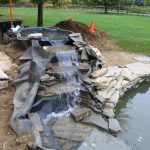Mill ponds have been a part of human history for centuries, serving as vital components of early industrialization and as serene natural features in rural landscapes. These man-made bodies of water have played a significant role in shaping the environment and supporting various forms of life. In this article, we will delve into the fascinating world of mill ponds, exploring their origins, purposes, and ecological impact.
Make A Pond Easily In A Short Time Using These
The History of Mill Ponds
Mill ponds have a rich historical background, dating back to ancient civilizations where water was harnessed to power various mechanical devices. The concept of using water as a source of energy for grinding grain and performing other essential tasks led to the creation of mill ponds. In Europe and North America, mill ponds became integral to the development of early industries, providing the power needed to drive water wheels and machinery.
These ponds were typically formed by constructing a dam across a river or stream, creating a reservoir of water that could be channeled to power nearby mills. The resulting body of water, known as a mill pond, became a central feature in many rural communities, supporting agricultural and industrial activities.
The Purpose of Mill Ponds
Mill ponds served as crucial components of early industrial infrastructure, enabling the efficient operation of mills and other water-powered machinery. The stored water in a mill pond provided a consistent and reliable source of energy, allowing for the continuous grinding of grains, sawing of timber, and various other manufacturing processes.
Besides their industrial significance, mill ponds also played a role in regulating water flow and preventing flooding in downstream areas. The dams that created these ponds helped to control the release of water, reducing the risk of seasonal flooding and ensuring a more stable water supply for surrounding communities.
Furthermore, mill ponds often provided a source of irrigation for nearby farmlands, enhancing agricultural productivity and supporting local economies. The water stored in these ponds could be released as needed to nourish crops and sustain livestock, contributing to the overall prosperity of rural regions.

Credit: en.wikipedia.org
The Ecology of Mill Ponds
From an ecological perspective, mill ponds have a profound impact on the surrounding environment, creating unique habitats for a diverse array of plant and animal species. The calm, still waters of these ponds support aquatic life, including fish, amphibians, and aquatic plants, while also attracting various bird species that rely on the water for sustenance.
Over time, mill ponds can undergo natural succession, with vegetation gradually colonizing the shallow edges and providing habitat for insects, small mammals, and birds. This process contributes to the overall biodiversity of the area, enhancing the ecological value of the pond and its surrounding wetlands.
Additionally, the presence of a mill pond can influence the hydrology of the landscape, affecting groundwater recharge and influencing the flow of nearby streams and rivers. These interconnected water systems create a dynamic environment that supports a wide range of flora and fauna, contributing to the overall resilience of the ecosystem.
Conservation and Restoration Efforts
As the role of mill ponds in industrial production has diminished over time, many of these historic features have fallen into disrepair or faced environmental challenges. However, there is a growing recognition of the cultural and ecological significance of mill ponds, leading to efforts to conserve and restore these valuable water resources.
Conservation initiatives often focus on preserving the historic structures associated with mill ponds, such as the dams, spillways, and mill buildings. By maintaining these elements of industrial heritage, communities can honor their past while creating opportunities for cultural tourism and educational outreach.
Restoration projects also aim to enhance the ecological function of mill ponds, improving water quality, restoring natural habitats, and promoting the sustainable use of these water bodies. Through careful management and stewardship, mill ponds can continue to contribute to the beauty and biodiversity of the landscape, serving as valuable assets for both people and wildlife.
Recreational and Aesthetic Value
Beyond their historical and ecological significance, mill ponds offer recreational and aesthetic benefits to local residents and visitors. These tranquil bodies of water provide opportunities for fishing, boating, and wildlife observation, allowing people to connect with nature and experience the peaceful ambiance of a rural landscape.
The scenic beauty of a well-maintained mill pond adds to the charm of the surrounding countryside, creating picturesque vistas that inspire artists, photographers, and nature enthusiasts. Whether framed by autumn foliage, spring blossoms, or winter snow, a mill pond evokes a sense of timeless serenity that captivates the imagination and soothes the soul.

Credit: dictionary.cambridge.org
Conclusion
In summary, mill ponds embody a rich tapestry of history, industry, ecology, and culture. These enduring features of the landscape have shaped human civilization and supported diverse ecosystems, leaving a legacy of resilience and beauty that continues to inspire admiration and stewardship. As we strive to balance the preservation of our heritage with the sustainable management of natural resources, the significance of mill ponds remains a testament to the enduring harmony between humanity and the environment.




